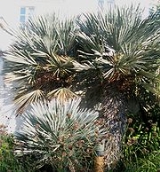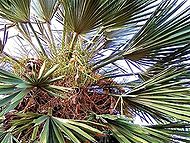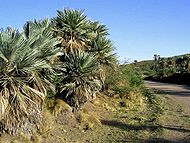
Trithrinax campestris
Encyclopedia
Trithrinax campestris or caranday palm is a South America
n arecaceae
palm native of Uruguay
an and northeastern Argentine
sabanas, where it shares its habitat with Copernicia alba
among others and extends also to the summits of mountain ranges of Sierras de Córdoba and Sierras de San Luis. It is a very rustic palm that grows in arid, well drained, rocky soils. Its distinctive features are its compact shape, short green to grayish foliage, and trunk fully hidden by dry dead branches (coat) remaining from several previous seasons.
flowering
palm of relative low height (up to 6 m tall) and 20–25 cm wide stems usually covered by remains of earlier foliage that act as a thick protective coat. Caranday leaves are about 1 m long, palmate, rounded, with a very rigid and spiny petiole
.
 The leaflet segments are rigid, dark green to a more blue hue, with light green undersides. These are possibly the toughest leaves among arecaceae
The leaflet segments are rigid, dark green to a more blue hue, with light green undersides. These are possibly the toughest leaves among arecaceae
. As habitat altitude increases the foliage becomes more grayish, this is typical of mountain carandays. Flowers compose highly branched inflorescence
s located at the base of the lower living leaves. These contain up to 100 white hermaphrodite
flowers 10 to 12 mm wide. This palm flowers in autumn. Fruits ripen towards the end of the next summer. They consist of subspherical yellow brownish drupe
s, 1 to 2 cm wide, with a thin fleshy mesocarp and a fibrous endocarp. Caranday is monoecious
, a feature common to the conifers but rare in angiosperms.
 Trithrinax campestris prefers well drained, sandy or rocky soils (although it is ignorant to extended persistent flooding). It is very resistant to drought, and -9°C/-15°C temperatures when not in growing season; else leaves are promptly discarded. It is one of the most cold-hardy palms
Trithrinax campestris prefers well drained, sandy or rocky soils (although it is ignorant to extended persistent flooding). It is very resistant to drought, and -9°C/-15°C temperatures when not in growing season; else leaves are promptly discarded. It is one of the most cold-hardy palms
in the world, this is because it also grows in the mountains of Sierras de Córdoba and Sierras de San Luis, it is known that specimens growing at those elevations tolerate special cold conditions. It has thrived as north as the British Isles
. Seeds germinate quickly but later growth is mostly slow.
This palms are naturally found in groups, formations of several individuals or composing largue caranday forests where they present strong dominance. Its main environmental threat is deforestation or natural fire, caranday thick dry stem coats are highly flammable.
.
Caranday palms are also appreciated and grown worldwide as an easy to keep, cold weather and drought resistant, ornamental small palm.
It is besides a good honey-producing plant
South America
South America is a continent situated in the Western Hemisphere, mostly in the Southern Hemisphere, with a relatively small portion in the Northern Hemisphere. The continent is also considered a subcontinent of the Americas. It is bordered on the west by the Pacific Ocean and on the north and east...
n arecaceae
Arecaceae
Arecaceae or Palmae , are a family of flowering plants, the only family in the monocot order Arecales. There are roughly 202 currently known genera with around 2600 species, most of which are restricted to tropical, subtropical, and warm temperate climates...
palm native of Uruguay
Uruguay
Uruguay ,officially the Oriental Republic of Uruguay,sometimes the Eastern Republic of Uruguay; ) is a country in the southeastern part of South America. It is home to some 3.5 million people, of whom 1.8 million live in the capital Montevideo and its metropolitan area...
an and northeastern Argentine
Argentina
Argentina , officially the Argentine Republic , is the second largest country in South America by land area, after Brazil. It is constituted as a federation of 23 provinces and an autonomous city, Buenos Aires...
sabanas, where it shares its habitat with Copernicia alba
Copernicia alba
Copernicia alba is a South American species of palm tree, which is found in the humid part of the Gran Chaco ecoregion in Bolivia, Paraguay, Colombia, Brazil and Argentina . They often, but not always, form dense single-species woodlands...
among others and extends also to the summits of mountain ranges of Sierras de Córdoba and Sierras de San Luis. It is a very rustic palm that grows in arid, well drained, rocky soils. Its distinctive features are its compact shape, short green to grayish foliage, and trunk fully hidden by dry dead branches (coat) remaining from several previous seasons.
Morphology
Trithrinax campestris is a monocotMonocotyledon
Monocotyledons, also known as monocots, are one of two major groups of flowering plants that are traditionally recognized, the other being dicotyledons, or dicots. Monocot seedlings typically have one cotyledon , in contrast to the two cotyledons typical of dicots...
flowering
Flowering plant
The flowering plants , also known as Angiospermae or Magnoliophyta, are the most diverse group of land plants. Angiosperms are seed-producing plants like the gymnosperms and can be distinguished from the gymnosperms by a series of synapomorphies...
palm of relative low height (up to 6 m tall) and 20–25 cm wide stems usually covered by remains of earlier foliage that act as a thick protective coat. Caranday leaves are about 1 m long, palmate, rounded, with a very rigid and spiny petiole
Petiole (botany)
In botany, the petiole is the stalk attaching the leaf blade to the stem. The petiole usually has the same internal structure as the stem. Outgrowths appearing on each side of the petiole are called stipules. Leaves lacking a petiole are called sessile, or clasping when they partly surround the...
.

Arecaceae
Arecaceae or Palmae , are a family of flowering plants, the only family in the monocot order Arecales. There are roughly 202 currently known genera with around 2600 species, most of which are restricted to tropical, subtropical, and warm temperate climates...
. As habitat altitude increases the foliage becomes more grayish, this is typical of mountain carandays. Flowers compose highly branched inflorescence
Inflorescence
An inflorescence is a group or cluster of flowers arranged on a stem that is composed of a main branch or a complicated arrangement of branches. Strictly, it is the part of the shoot of seed plants where flowers are formed and which is accordingly modified...
s located at the base of the lower living leaves. These contain up to 100 white hermaphrodite
Plant sexuality
Plant sexuality covers the wide variety of sexual reproduction systems found across the plant kingdom. This article describes morphological aspects of sexual reproduction of plants....
flowers 10 to 12 mm wide. This palm flowers in autumn. Fruits ripen towards the end of the next summer. They consist of subspherical yellow brownish drupe
Drupe
In botany, a drupe is a fruit in which an outer fleshy part surrounds a shell of hardened endocarp with a seed inside. These fruits develop from a single carpel, and mostly from flowers with superior ovaries...
s, 1 to 2 cm wide, with a thin fleshy mesocarp and a fibrous endocarp. Caranday is monoecious
Plant sexuality
Plant sexuality covers the wide variety of sexual reproduction systems found across the plant kingdom. This article describes morphological aspects of sexual reproduction of plants....
, a feature common to the conifers but rare in angiosperms.
Habitat

Hardy palms
Hardy palms are any of the species of palm that are able to withstand colder temperatures and thrive in places not typically considered in the natural range for palms. Several are native to higher elevations in Asia and can tolerate hard freezes with little or no damage...
in the world, this is because it also grows in the mountains of Sierras de Córdoba and Sierras de San Luis, it is known that specimens growing at those elevations tolerate special cold conditions. It has thrived as north as the British Isles
British Isles
The British Isles are a group of islands off the northwest coast of continental Europe that include the islands of Great Britain and Ireland and over six thousand smaller isles. There are two sovereign states located on the islands: the United Kingdom of Great Britain and Northern Ireland and...
. Seeds germinate quickly but later growth is mostly slow.
This palms are naturally found in groups, formations of several individuals or composing largue caranday forests where they present strong dominance. Its main environmental threat is deforestation or natural fire, caranday thick dry stem coats are highly flammable.
Usage
Leaves are rich in strong fiber, very resistant to tension. It is extracted to manufacture crafts as hats, shoes and fans. Whole leaves are cut and used as rudimentary brushes. Fruits are not eaten, however, an alcoholic beverage is prepared locally through their fermentationFermentation (food)
Fermentation in food processing typically is the conversion of carbohydrates to alcohols and carbon dioxide or organic acids using yeasts, bacteria, or a combination thereof, under anaerobic conditions. Fermentation in simple terms is the chemical conversion of sugars into ethanol...
.
Caranday palms are also appreciated and grown worldwide as an easy to keep, cold weather and drought resistant, ornamental small palm.
It is besides a good honey-producing plant

